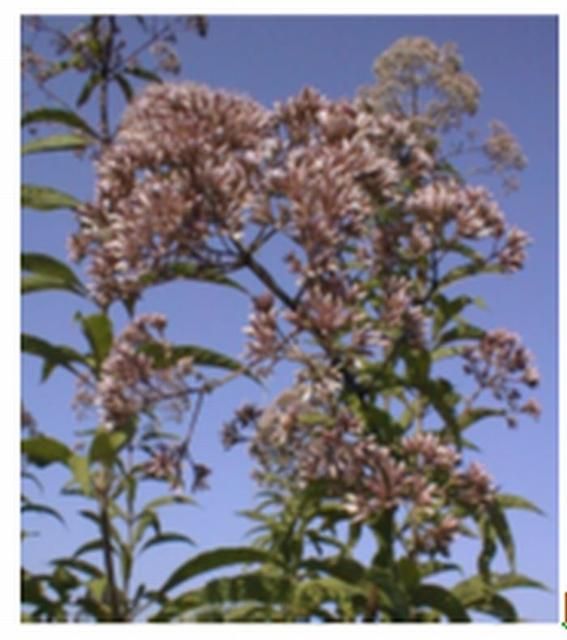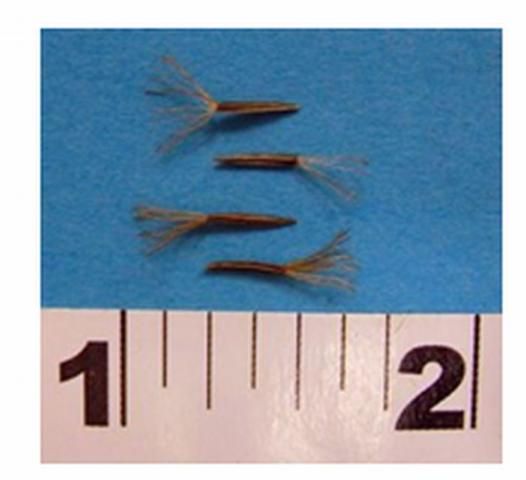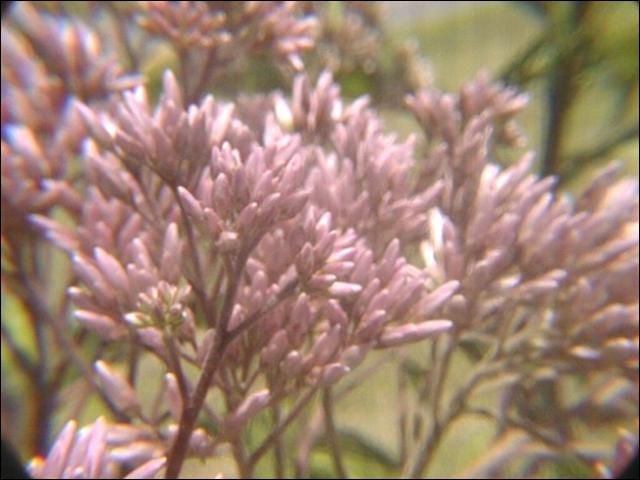Description
Joe-Pye weed (Eupatorium fistulosum Barratt; synonym Eupatoriadelphus fistulosus [Barratt] King & H.E. Robins) is an herbaceous perennial native from Maine to Michigan, south to central Florida and Texas (USDA Hardiness Zones 3–9; AHS Heat Zones 2–10). It grows best in moist to slightly moist, well-drained soil under full sun to partial shade (Eupatoriadelphus fistulosus [Barratt] King & H. E. Robins 2011; Kirk and Belt 2009).
This upright plant grows 3–10 feet tall (height is related to moisture level) and has dark green whorls of lance-shaped leaves up to 10 inches long. During the summer, Joe-Pye weed bears showy panicles of dusty rose to lavender flowers (Figure 1). Individual flowers are small (1/2 inch), but the panicles can be up to 18 inches in diameter. The showy panicles attract butterflies, skippers, beetles, bees, and wasps (Floridata.com LC 2001) (Figure 2).


The height of this species, along with its large panicles of flowers, make it quite striking in home landscapes as well as fields and pastures, along road shoulders, and at the edges of woods, marshes, and streams. But the height, which adds to its attractiveness, is of concern for nurseries that want to produce it in containers. Tall plants easily blow over during production and can be difficult to ship.
This publication describes a production protocol that results in plants that are only 18–24 inches tall when they are ready to ship.
Origin of Propagules
The origin of the plant material (seeds or plants) is a factor that should be considered when growing Joe-Pye weed. By origin, we mean the geographical location from which the plant material was originally derived. For example, stock plants from which all future seeds or cuttings are harvested might have been grown from seeds harvested from a naturally occurring population in Jefferson County, Florida. Some geographic populations are cold hardy only to USDA Hardiness Zone 5, and some populations cannot survive heat stress south of Zone 7 (Floridata.com LC 2001). The flowering date of Joe-Pye weed might also be affected, as it is for other related wildflower species found over a similar range (Beckwith 1991; Cohn and Kucera 1969; Kucera 1958). Any effect on flowering is important because flower initiation is what stops Joe-Pye weed from growing taller.
Liner Production from Seed
Good germination can be obtained with seed from the current season (Figure 3). Seed should be ready to harvest by late August or early September. Sow freshly harvested seed within 2 weeks after harvest on a soilless medium designed for seed germination. Typically, seed germination rate is low, so sow seed heavily (Eupatoriadelphus fistulosus [Barratt] King & H. E. Robins 2011; Kirk and Belt 2009). Lightly cover the seed with the medium. Flats should be watered regularly so that the medium does not dry out. If using overhead watering, use a fine spray so as not to disturb the medium. If seed is limited, cold-moist storage (40°F) for up to 3 months should increase germination (Eupatoriadelphus fistulosus [Barratt] King & H. E. Robins 2011; Kirk and Belt 2009).

In 4–6 weeks, seedlings should be ready to transplant into liner pots or trays, especially if grown in a greenhouse; we use 2¼-inch pots. The potting medium should be a well-drained, soilless nursery mix, such as pine bark:Canadian sphagnum peat:sand (3:1:1, by vol.) amended with controlled-release fertilizer (low rate) and micronutrients. If seedlings were produced in a greenhouse, acclimatize freshly transplanted liners under 30%–40% shade for 4–7 days before moving them to full sun. After that, liners can remain under full sun.
During the winter, consider providing cold protection if temperatures are expected in the 20s or lower. The effect of subfreezing temperatures on these liners, especially the root systems, is not known, but you might want to err on the side of caution.
Container Production
During the second week of May, prune back liners so that they are 7–8 inches tall. Transplant the pruned liners into 1-gallon pots that contain the same well-drained, soilless nursery medium used for liner production, but amend that medium with a rate of controlled-release fertilizer about 40%–50% greater than what was used for liner production. Be sure to space plants far enough apart to allow for good air flow. Plants that are spaced too close together will develop leaf spot (see Pest Control).
About 8–10 weeks after liners are potted, at least one panicle of flowers should have fully elongated flower buds that are rosy purple but not fully opened (Figure 4). At this point, Joe-Pye weed is colorful enough to sell or ship.

Irrigation
Under North Florida late spring/early summer conditions, plants should be irrigated with about 1/3 inch water once per day; additional irrigation will be necessary during hot, dry weather. These irrigation rates are provided as a general guideline. Modify the frequency and amount of irrigation to suit your particular conditions. However, it is important not to overwater as that could lead to leaf spot diseases (see Pest Control).
Pest Control
Weeds in the pots have to be controlled manually and through good sanitation practices. There are no pre- or postemergence herbicides of which Joe-Pye weed is specifically mentioned as being tolerant.
Joe-Pye weed is susceptible to some leaf spot diseases, especially if plants are overwatered, or if there is poor air circulation around the plants. Leaf spot diseases we have observed are Cercospora eupatorii and Pseudocercospora spp. Powdery mildew (Oidium spp.) can also occur on the leaves. There are no fungicides specifically labeled for control of these diseases on Eupatorium spp. Contact your county Extension agent for a recommendation about general-use fungicides that can be used under nursery conditions to control these foliar diseases.
Although we have not observed any significant insect or mite infestations, feeding by grasshoppers, flea beetles, and saw flies has been noted (Kucera 1958).
References
Beckwith, D. D. 1991. "Characterization of Juvenility and Photoperiodic Responses of Rudbeckia hirta Originating from Different Latitudes." MS thesis. Blacksburg: Virginia Polytechnical Institute and State University.
Cohn, R. J., and C. L. Kucera. 1969. "Photoperiodic Adaptations in Eupatorium rugosum." American Journal of Botany 56:571–574.
"Eupatoriadelphus fistulosus (Barratt) King & H.E. Robins." 2011. Lady Bird Johnson Wildflower Center. Accessed February 3, 2012. http://www.wildflower.org/plants/result.php?id_plant=EUFI2.
Floridata.com LC. 2001. Eupatorium fistulosum. Floridata Encyclopedia of Plants and Nature. Accessed February 3, 2012. http://www.floridata.com/ref/e/eupa_fis.cfm.
Kirk, S., and S. Belt. 2009. "Hollow-Stemmed Joe-Pye Weed Eupatoriadelphus fistulosus (Barratt) King and H. Rob." U.S. Department of Agriculture, Natural Resources Conservation Service Plant Materials Center. Accessed February 3, 2012. http://plants.usda.gov/factsheet/pdf/fs_eufi2.pdf.
Kucera, C.L. 1958. "Flowering Variation in Geographic Selections of Eupatorium rugosum Houtt." Bulletin of the Torrey Botanical Club 85 (1): 40–48.